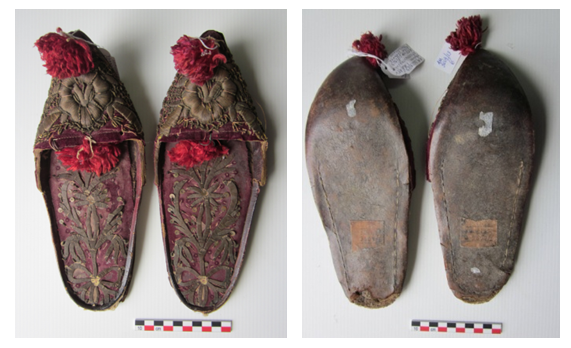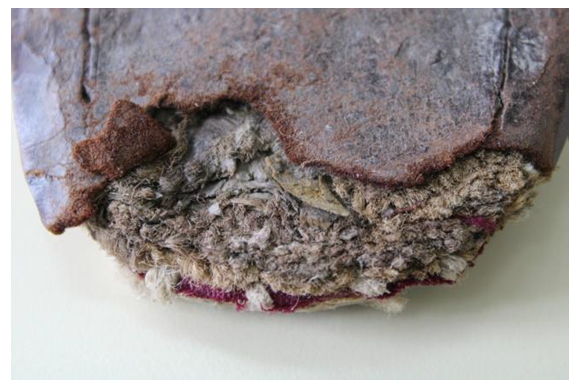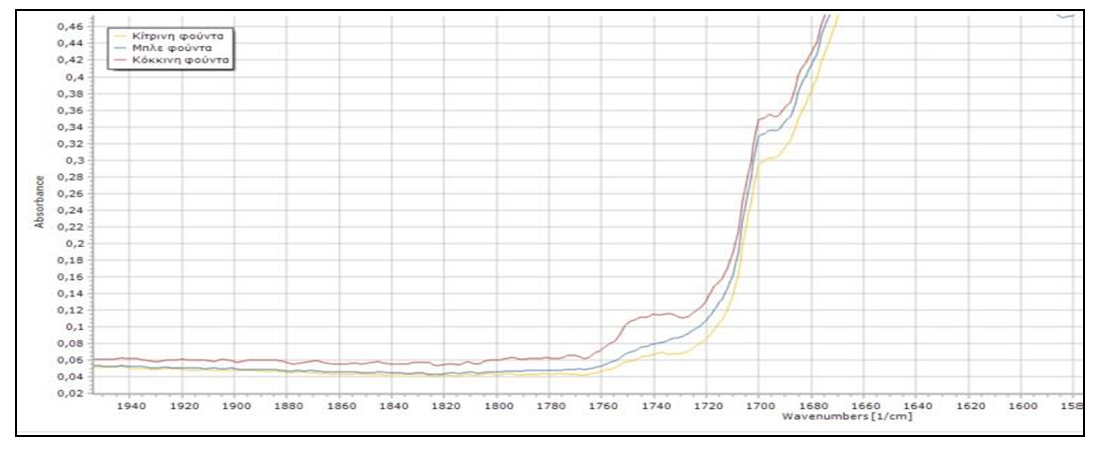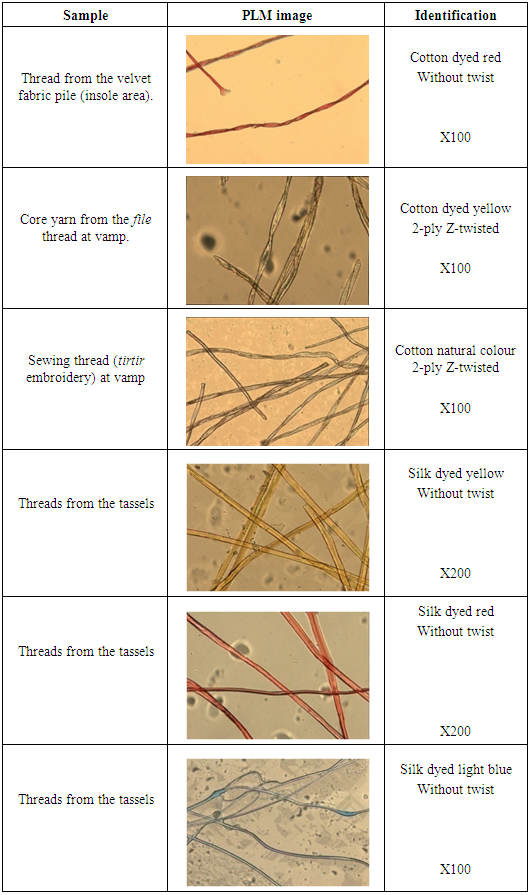-
Paper Information
- Next Paper
- Previous Paper
- Paper Submission
-
Journal Information
- About This Journal
- Editorial Board
- Current Issue
- Archive
- Author Guidelines
- Contact Us
Archaeology
p-ISSN: 2332-838X e-ISSN: 2332-841X
2021; 9(1): 14-20
doi:10.5923/j.archaeology.20210901.03

Study of a Pair of Traditional Women’s Shoes from Chios Island Dated to 1905
Arentona Fostriropoulou1, Anna Karatzani2
1Ephorate of Antiquities of Lasithi, Ayios Nikolaos, Crete, Greece
2Assistant Professor, University of West Attica, Ag. Spyridonos Str., Egaleo, Athens, Greece
Correspondence to: Arentona Fostriropoulou, Ephorate of Antiquities of Lasithi, Ayios Nikolaos, Crete, Greece.
| Email: |  |
Copyright © 2021 The Author(s). Published by Scientific & Academic Publishing.
This work is licensed under the Creative Commons Attribution International License (CC BY).
http://creativecommons.org/licenses/by/4.0/

This paper describes the analytical investigation of a pair of women’s shoes (known as slippers) from Pyrgi of Chios Island. The shoes belong to the Lyceum Club of Greek Women (Lykeion ton Hellenidon) traditional costume collection. They are dated to 1905 and were typically used on festive occasions. Shoes are composite objects with small dimensions with a complex construction and decorative elements and as such they pose difficulties to conservators. Moreover, shoes from that time are only rarely found in collections in Greece. Thus it was decided to perform a systematic investigation in order to obtain technological knowledge about the materials and techniques used for their manufacture. Analytical methods used to characterize the shoes’ components include Optical Microscopy (OM); Scanning Electron Microscopy coupled with Energy Dispersive Spectroscopy (SEM/EDX); Attenuated Total Reflectance-Fourier Transformed Infrared Spectroscopy (FTIR/ATR); X-radiography and X-Ray Computed Tomography (CT). The results obtained from the materials characterization study were also used to determine the condition of the slippers and plan for the appropriate treatment methodology.
Keywords: Shoes, Velvet fabric, Metal threads, Leather, OM, SEM/EDX, FTIR/ATR, X-Radiography, X-Ray Computed Tomography
Cite this paper: Arentona Fostriropoulou, Anna Karatzani, Study of a Pair of Traditional Women’s Shoes from Chios Island Dated to 1905, Archaeology, Vol. 9 No. 1, 2021, pp. 14-20. doi: 10.5923/j.archaeology.20210901.03.
Article Outline
1. Introduction
- The paper focuses on the study and material investigation of a pair of women’s shoes (slippers) from Pyrgi of Chios Island, which is part of the collection of the Club of Greek Women (Lykeion ton Hellenidon) in Athens. The shoes are dated to 1905 and were typically used on festive occasions. They are flat with a leather outsole and a velvet vamp decorated with red tassels and embroidered with metal threads and sequins. Both slippers are misshaped and the leather outsole is worn off. The velvet fabric is in good condition but the metal threads are corroded and some sequins and tassels are missing. Shoes are composite objects with a complex construction and decorative elements and as such they pose difficulties to conservators. The published information on methods developed for the conservation treatment of shoes is limited. They mostly deal with leather excavated shoes [1-5], while shoes are not discussed often in textile conservation texts [6-8].Shoes from that period are only rarely found in Greek collections, and it is hoped their study will provide both technological knowledge and information about the value and significance of such objects during the early 20th century. Similarities with Eastern shoes will be also explored due to the geographic location of Chios Island and to the known trade routes of that period [9]. Materials characterization was used to determine the composition of construction materials, to assess their condition and to help plan for the appropriate treatment proposal [10,11].Analytical methods used to characterize the shoes’ components include: Optical Microscopy (OM); Scanning Electron Microscopy coupled with Energy Dispersive Spectroscopy (SEM/EDX); Fourier Transformed Infrared Spectroscopy (FTIR/ATR); X-radiography and X-Ray Computed Tomography (CT). This methodology provided details of the materials used as well as the construction technology related to the successive layers of the sole (leather and supporting materials), their morphology and thickness and the joining techniques used. The velvet part (vamp) and the supporting layers together with the metal threads and the stitching used to secure it with the leather outsole were also recorded. The fibres of the velvet fabric and the tassels were identified as well as the metals and the core threads of the metal threads and the sequins. Based on the results obtained treatment options were explored in order to clean, reshape and stabilize all their individual parts.
2. The Slippers
2.1. Lyceum Club of Greek Women
- The Lyceum Club of Greek Women (Lykeion ton Hellenidon) was founded in 1911 by Callirrhoe Siganou-Parren, a pioneer of the feminist movement in Greece and the country's first woman journalist. It is a volunteer organization, which, for more than a century has played an active and important role in the preservation and presentation of Greek cultural traditions and folk customs. The Club has an important social contribution in the domain of adult education for women and the defence of women's rights [12]. Since 1991, a serious effort has been made by the Club to reorganize the Wardrobe and its rich collection of authentic regional costumes, today comprising more than 25.000 complete ensembles. The collection is housed in its Museum of the History of the Greek Costume inaugurated in 1988. A part of the collection comprising 4.100 documented and digitized costumes and objects is available online [12]. A limited number of shoes are included among the Club’s collection and thus it was important to study and treat some of them in order to obtain information about the technology and the materials employed for their construction.
2.2. Description of the Slippers
- The slippers (figure 1a) are flat with pointed upturned toes and have a textile vamp (the top part of the shoe from toe to instep) and leather outsole [13]. There is no difference in shape between the left and the right slipper [14], but it is possible to separate them due the deformation created during use. A purple velvet fabric with metal thread embroidery is used both as vamp and for the insole. The metal thread embroidery forms flowers in raised technique with file threads surrounded by patterns with tirtir threads on the vamp. The decoration on the insole comprises of a floral pattern made of file and tirtir threads and sequins [15]. Cardboard is used as support for the metal thread embroidery on both fabrics. Tassels made of red and some coloured threads were also used for their decoration, one is secured with stitching at each pointed edge and a smaller one at the center of the vamp edge, secured with a thread. The leather outsole is partly sewed and partly glued to the shoe upper. A square paper tag with their accession number is glued on each outsole, while another tag is attached with a thread on each of the tassel at the shoe front (figure 1b).
 | Figure 1. a) Front view of slippers, b) Back view of the slippers |
2.3. Condition of the Slippers
- The slippers are in poor condition. They are dirty and misshaped, and both leather outsoles are totally worn off at the heel area leaving the internal support layers visible (figure 2a). The leather is dry and cracked and a small part is missing from the area of the pointed front on both slippers. The purple velvet fabric of the insole has faded and the pile is partly lost. The ground fabric of the velvet is also worn off in some areas revealing the woven support fabric underneath it, while in other areas it is covered with dirt. The metal threads and sequins are corroded and have lost their original shinny appearance. Many sequins are missing as can be seen from the colour difference on the velvet fabric (figure 2b). On the left slipper a small part of the metal thread embroidery is also missing (both the supporting cardboard and file threads). The velvet fabric at the vamp is in better condition, but the metal threads are also corroded and many tirtir threads are easily detached from the velvet fabric due to the sewing thread failure. Only two tassels are present on each slipper one at the pointed front and a smaller one at the center of the vamp opening. The two holes on the vamp on each side of the central tassel indicate that two more tassels were originally attached. The tassels’ threads are untangled and dirty and they are loosely connected to the vamp. Finally the red leather used as welt (rim of the slipper), is dry and cracked and is covered with dirt at the area close to the heels.
 | Figure 2a. Detail of the worn off leather outsole at the heel area |
3. Methodology-Results
- Materials characterization was used to determine the composition of construction materials and condition of the slippers to help plan for the appropriate treatment.
3.1. Optical Microscopy
- The study of the object under the microscope gave information about twisting of fibers and types of metal threads, the velvet fabric and the condition of leather, metals and fibers [16,17]. Subsequently, samples of the metal threads, the velvet fabric and the tassels were observed with a Leica DMLP Polarizing Microscope in order to identify the various fibers used. The velvet (ground fabric and pile) is made of cotton. Cotton is also used as core for the metal threads and as sewing thread for the tassels and the tirtir threads (table 1). The cotton fibers are brittle and dirty, while the metal threads are corroded and in some areas are untangled (figure 5). The tassels, even though there is a colour and size difference among them, are all made of silk threads. Finally, the sequins are made by punching with a hexagonal opening in the center [18,19].
|
3.2. X-ray Radiography
- X-ray radiography was used to determine the manufacturing methods used for the production of the slippers, as well as the state of preservation of the component parts which are not visible with visual observation [20,21]. Both the upper and the side of the objects were studied aiming to visualize the component material distribution. After digitally adjusting the radiographs the metal thread embroidery was clearly observed with the stitching used to secure them and the paper support on the velvet fabric. The structure of the thick fabric under the velvet at the insole was also very clear. However, it was not possible to obtain more information about the layers comprising the sole, which prompted its further investigation through CT scan (figure 3).
3.3. X-Ray Computed Tomography
- X-Ray Computed Tomography was used in order to examine the insole materials and construction [22,23]. With the successive small sections of the object both horizontally and vertically, internal deformations of the construction materials were determined, explaining the shape of the slipper’s. Furthermore, it was possible to identify the successive layers of the sole (leather and supporting materials). It was concluded that the sole comprises of a total of 8 layers including the leather outsole and the velvet fabric. Moreover, not all the inner layers of the sole present the same absorption which is highlighted by the variation in gray tones, suggesting the presence of different materials.The velvet vamp consists of three layers including also the velvet fabric. The two others, due to their similar absorption and appearance in combination with the macroscopic observation, are concluded to be both made of leather.The CT scans helped in understanding the construction of the shoe indicating the course of the seams, the space between the stitches and the layers each time the stitch connects. It was also possible to determine the weaving of the fabric at the inner layer of the sole, which is tabby (1:1). Finally, information concerning the internal art of the shoe and its condition was obtained. Its deformation and the large gaps between the layers became visible (figure 4).
3.4. SEM/EDX
- The composition of the metal threads, the determination of their condition (figure 5), as well as measurements of their width, thickness and diameter were made possible with SEM-EDX [15,24]. A JEOL JSM–6510LV, Scanning Electron Microscope on low pressure vacuum 20Pa, and 20kV accelerating voltage was used for imaging and the elemental analysis of the samples was carried out on low pressure vacuum 25Pa, 20kV accelerating voltage at 15mm working distance. The instrument is equipped with an X–act Pentafet Precision detector (INCA analysis system, Oxford Instruments).
 | Figure 6. Photomicrograph of a tirtir thread cross section and elemental maps showing Cu and Zn distributions |
3.5. FTIR/ATR
- FTIR-ATR spectrums further confirmed the data obtained from the OM study of fibers [26]. A Perkin Elmer Spectrum GX FTIR spectrometer equipped with DTGS detector and a Pike MIRacle ATR ZnSe crystal (2mm sample diameter, 2.4 refractive index) was used. A total of 20 scans per spectra were performed at 1cm−1 interval with 4.0 cm-1 resolution. Measurements were recorded between 4000 and 520 cm−1 in both cases.Cotton and silk threads were identified, either by using a known data base or by investigating the vibrations of the molecules that appear as peaks and identifying them bibliographically [27], taking also into account the results from all the others techniques used (figure 7). Furthermore the condition of these threads was also determined, since differences from the reference samples were also identified.
 | Figure 7. ATR/FTIR spectrum of the various coloured threads from the tassels |
 | Figure 8. ATR/FTIR spectrum of the absorption bands at 1700-1775cm-1 in the free carbonyl region indicating the degradation of silk |
4. Discussion -Conclusions
- The study of the slippers and the analysis of the samples provided useful information regarding the materials used, the manufacturing process and their state of preservation.The organic fibers were identified as well as the types of metal threads. SEM/EDX revealed the morphological characteristics of the metallic decorative elements and the metals present, namely Cu and Zn. Moreover, the cross section analysis made clear that all the metallic decorations comprise of a copper body and a brass coating (Cu, Zn), possibly to imitate the yellow hue of gold. X-radiography did not provide the expected results due to the high absorption of the metals compared to the textile and leather parts; however, it was possible to determine the methods of attaching the metal threads on the velvet fabric while the decorative patterns of the embroidery were also highlighted. Finally, the identification of multiple layers at the sole was an important finding which prompted its further investigation through CT scan.By studying the CT scans it was possible to identify the number of layers comprising the sole (eight in total) and their dimensions, the three layers comprising the vamp and the width of the paper support of the metal thread embroidery. Through the CT scans the direction of the seams, the space between the stitches as well as the layers it connects at the various parts were determined. Moreover, the tabby weave of the supporting fabric in the sole was also identified. Finally, due to the high penetration of the X-rays details concerning the interior of the slippers were obtained, and their condition was determined. Deformations of the sole and large gaps were identified suggesting the different pressure from the wearer’s foot.The ATR/FTIR analysis of the slippers further confirmed the identification of the organic threads (velvet, tassels, sewing threads and organic core of the file threads). It also gave information about their condition since the relevant peaks were observed. Shoes always preserve the shape of the wearer’s body and a close inspection of such objects can provide information about their utility and comfort. Signs of damage or modifications can inform about their use and changes in fashion. Even macroscopic observation can show how often they were worn; which parts show the greatest wear, whether there are signs or repair or alterations etc. It is therefore important to study them carefully before undertaking any conservation treatment and try not to alter such information [30]. The methodology followed proved to be sufficient for obtaining all the data needed for completely “comprehend” the slippers. Especially since shoes are not often found in Greek collections and the opportunity to study such object is limited.
ACKNOWLEDGEMENTS
- The authors want to thank: “The Lykeio ton Hellenidon” for providing the wonderful objects and the permission for sampling them. Dr St. Boyatzis for the FTIR/ATR analysis, Dr V. Argyropoulos for providing access to TC analysis, Mr Th. Panou for the X-ray radiography, Ms M. Dousi for the TC analysis and Mr Th. Karabotsos for the help with SEM/EDS analysis.
 Abstract
Abstract Reference
Reference Full-Text PDF
Full-Text PDF Full-text HTML
Full-text HTML



